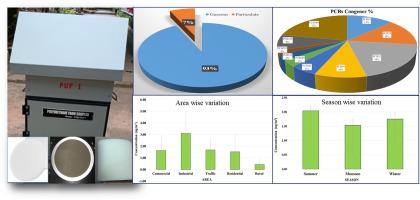Assessment of polychlorinated biphenyls (PCBs) in ambient air and its health risk evaluation in an urban city, Bangalore, India
IF 3.4
Q2 ENVIRONMENTAL SCIENCES
引用次数: 0
Abstract
In recent years, polychlorinated biphenyls (PCBs) in the environment have gained scientific interest because of their persistent nature, widespread occurrence, and the potential threats they pose to humans and the environment. Urban populations are exposed to PCBs through inhalation, ingestion, and dermal absorption of particles present in the air. The present study aimed to evaluate the gaseous and particulate PCB concentrations present in the ambient air based on various seasons and locations and to evaluate the health risks associated with PCBs in urban areas of Bangalore, Karnataka, India. A total of 180 (each PUF and filter paper) samples were collected for the analysis of PCBs in ambient air. PCBs in filter paper and polyurethane foam (PUF) were extracted by ultra-sonication and soxhlet extraction methods, respectively, and analyzed using GC-MS/MS. The maximum mean ∑10PCBs concentration was observed in industrial areas (3.11 ng/m3) and the minimum concentration in rural areas (0.44 ng/m3). Similarly, among the different seasons monitored, the maximum values were observed in the summer season (2.04 ng/m3) and the minimum was in the monsoon season (1.53 ng/m3). The USEPA exposure risk model was used to assess the carcinogenic and non-carcinogenic risks of population exposure to PCBs. The current finding indicates that the carcinogenic risk from ∑10PCBs through inhalation exposure was lower than the permissible limit (1.0E-04) for the urban population. The population residing near industrial, traffic, commercial, and residential areas has a slightly high carcinogenic risk through inhalation exposure and dermal contact. This study demonstrated that Inhalation is the primary route of atmospheric PCB exposure, leading to an increased carcinogenic risk for urban population. Therefore, to alleviate the situation and safeguard humans, further continuous monitoring of other toxic contaminants and investigations of biomarkers are highly recommended.

印度班加罗尔某城市环境空气中多氯联苯(PCBs)的评估及其健康风险评价
近年来,环境中的多氯联苯(PCBs)因其持久性、广泛存在性以及对人类和环境的潜在威胁而引起了科学界的关注。城市人口通过吸入、摄入和皮肤吸收空气中存在的颗粒而暴露于多氯联苯。本研究旨在根据不同季节和地点评估环境空气中存在的气态和颗粒多氯联苯浓度,并评估印度卡纳塔克邦班加罗尔城市地区与多氯联苯相关的健康风险。共收集了180份(每个PUF和滤纸)样本用于分析环境空气中的多氯联苯。分别采用超声波法和索氏提取法提取滤纸和聚氨酯泡沫(PUF)中的多氯联苯,并采用气相色谱-质谱联用仪(GC-MS/MS)进行分析。工业地区平均∑10pcb浓度最高(3.11 ng/m3),农村地区平均∑10pcb浓度最低(0.44 ng/m3)。同样,在不同的监测季节中,夏季最大(2.04 ng/m3),季风季节最小(1.53 ng/m3)。使用USEPA暴露风险模型来评估人群暴露于多氯联苯的致癌和非致癌风险。目前的研究结果表明,通过吸入接触∑10PCBs的致癌风险低于城市人口的允许限值(1.0E-04)。居住在工业、交通、商业和居民区附近的人口通过吸入接触和皮肤接触具有稍高的致癌风险。本研究表明,吸入是大气中多氯联苯暴露的主要途径,导致城市人口致癌风险增加。因此,为了缓解这种情况和保护人类,强烈建议进一步持续监测其他有毒污染物和研究生物标志物。
本文章由计算机程序翻译,如有差异,请以英文原文为准。
求助全文
约1分钟内获得全文
求助全文
来源期刊

Atmospheric Environment: X
Environmental Science-Environmental Science (all)
CiteScore
8.00
自引率
0.00%
发文量
47
审稿时长
12 weeks
 求助内容:
求助内容: 应助结果提醒方式:
应助结果提醒方式:


